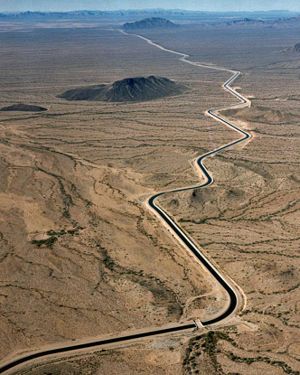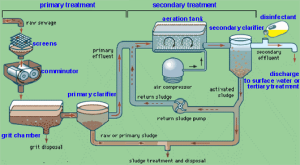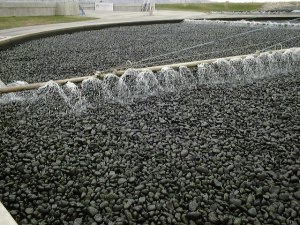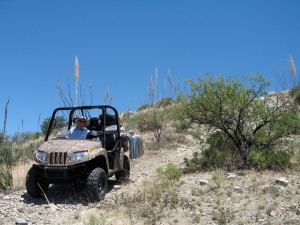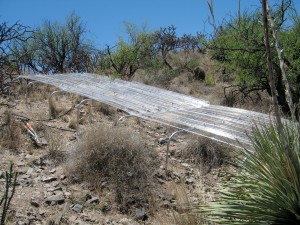Hi all. As I was riding my bike to school avoiding all the puddles, I was thinking about where the water we drink in Tucson comes from. If you think about it, we don’t have any flowing rivers (for all of you not from Tucson, we have “washes,” which are dry river beds that flood every so often during a large rain event – image to the right), but when we turn on our taps, water flows out. So where do we get our water?

Rillito River, Tucson, AZ. Courtesy of http://www.tucsonazrealestateblog.com/tucson-real-estate/.
Historically, Tucson has pumped water from the regional aquifer (sediments below the surface that are saturated with water – like a sponge); while our population was small, this was a renewable source of water via rainfall percolating down to the aquifer. As Tucson’s population began to rise, with it the need for water, we started to overpump, or mine, our aquifer. This lead to lowered water tables, higher costs for water, and a bleak outlook for the future of Tucson and its water needs.
In 2001, Tucson began to mix Colorado River water brought down south via the CAP (Central Arizona Project – which is a canal that brings Colorado River water from northern Arizona to southern Arizona). Mixing the water with groundwater allowed the water utility to recharge some of the aquifer with CAP water. Adding CAP water to the mix has allowed the water utility to shut down some pumping wells and as a result the water table has risen in some places. If you’re interested in learning more about what Tucson’s water plan, please follow this link for more information: http://www.ci.tucson.az.us/water/waterplan.htm.

Central Arizona Project (CAP): Brings billions of gallons of Colorado River water to southern Arizona each year.
However, the population of Tucson has continued to increase and we only have access to a set amount of CAP water, 40 billion gallons of water each year to be exact. We only use about 22 billion gallons per year currently, but with people moving to Tucson for the sun and the golf, we will exceed our allocation of CAP water in the near future. This means that we’ll have a “water problem” again with no clear solution in sight.
So what can we do? Well there are a few things we can do to help our water situation.
(1) Water Conservation: The less water we use the less water Tucson needs to use as a city. We can put in native vegetation in our yards that need minimal watering or no watering (just imagine never having the mow your lawn again…). Shut off the tap when we brush our teeth and shave, take showers rather than baths, only wash our cars once in a while rather than every weekend. Making simple changes will help conserve millions of gallons of water each year, and lower your water bill at the same time.
(2) Reuse Water: Reusing water that we’ve used for clothes washing may seem a little weird, but water your garden with washing machine water (sometimes called “gray water”) can save a lot of water in the long run. Besides, your plants don’t care what kind of water they get; it’s pretty much all the same to them. Here’s an example of gray water reuse: http://www.builditsolar.com/Projects/Water/Water.htm.
 (3) Rainwater Harvesting: Now this sounds a little hippyish, but rainwater harvesting is big business in Tucson. Saving rainwater in cisterns to water your yard is easy and cheap (i.e. free, if your subtract the cost of the cistern). Go to this link for more info: http://www.builditsolar.com/Projects/Water/Water.htm, http://www.harvestingrainwater.com/rainwater-harvesting-inforesources/.
(3) Rainwater Harvesting: Now this sounds a little hippyish, but rainwater harvesting is big business in Tucson. Saving rainwater in cisterns to water your yard is easy and cheap (i.e. free, if your subtract the cost of the cistern). Go to this link for more info: http://www.builditsolar.com/Projects/Water/Water.htm, http://www.harvestingrainwater.com/rainwater-harvesting-inforesources/.
Water is a precious and limited resource, if we all make small changes in our lives, we will have a large impact on conserving this vital resource for the future.
